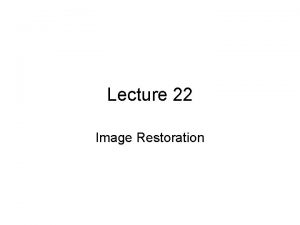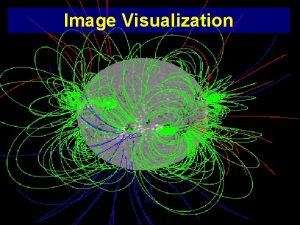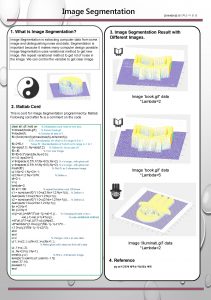MADE IN THE IMAGE OF GOD MADE IN
























- Slides: 24

MADE IN THE IMAGE OF GOD

MADE IN THE IMAGE OF GOD Then God said, “Let us make humankind in our image, according to our likeness…” So God created humankind in his image In the image of God he created them Male and female God created them

MADE IN THE IMAGE OF GOD § Being Human § Being Sexual § Being Connected § Being Moral

Being Human We respond to the belief that we are created in the image and likeness of God, and called to demonstrate reverence for self and others.

Being Sexual We explore the belief that sexuality is integral to the human person and develop an understanding of the teachings of the Catholic Church regarding human sexuality.

Being Connected We explore how God is revealed to us in and through relationships with family, friends and community, and demonstrate a respect for diversity.

Being Moral We respond to the belief that we are called to be moral and investigate and apply these processes in Christian decision making.

VALUES ¨ English ¨ Maths ¨ Science ¨ SOSE ¨ LOTE ¨ Health ¨ Arts ¨ Technology ¨ RE

What are Values? ª Deeply held, sometimes unknown, often unarticulated and formed from many sources. ª Intertwined and interdependently linked with our attitudes, commitments, beliefs emotions and actions.

Values and Principles -Common Good -Community -Compassion -Concern -Courage -Dignity of the -human person -Family -Forgiveness -Freedom -Goodness -Hope -Interconnectedness -Interdependence -Justice -Love -Peace -Respect -Responsibility -Reverence -Sanctity of life -Stewardship -Wonder and awe

What do you think are the most significant influences or shaping forces on the values that you hold?

What is human sexuality?

Sexuality – A Catholic Perspective Sexuality refers to a fundamental component of personality in, and through, which we, as male or female, experience our relatedness to self, others, the world, and God US Catholic Conference Human Sexuality n. 9

Catechism of the Catholic Church Sexuality affects all aspects of the human person in the unity of his/her body and soul. It especially concerns affectivity, the capacity to love and to procreate and in a more general way the aptitude forming bonds of communion with others. CCC #2332

Human Sexuality Education in human sexuality is a lifelong process, a developmental learning experience that ripens, evolves, and, it is hoped, matures across the years and the decades. Human Sexuality p. 78

Sexuality as Human Sexuality …is not something simply biological, but concerns the innermost being of the human person… CCC 2361 • As human persons, sexuality is integral to who we are • It has physical biological dimensions, as well as emotional, social and spiritual dimensions • These cannot be separated from each other and are all involved in our sexual expression • Humans gradually mould their sexual selves. • Sexuality is a life-long task.

Sexuality as Gift – it is not good for the human being to be alone �Christians believe human purpose is to love �Sexuality enables humans to love �As humans, with free will, we can strive to integrate our sexuality – that is to embrace it as ourselves and allow it to serve our human purpose of loving. �Humans can also dis-integrate our sexuality – to use it only to serve ourselves– the opposite of love.

Sexual Expression as Human • Sex is beyond biology and has many ‘meanings’, not withstanding, but beyond its procreative power. • Human sexuality is ‘other-directed’. Sex for one’s own fulfillment treats the other as a means to an end – and therefore is dehumanising. • Sex is ‘self-giving’. It tells the other that they are valued and worthwhile in a most dramatic way. • Sexuality is a language. In its ideal form, it is a language of love and commitment. Gerald D Coleman, SS Human Sexuality An All Embracing Gift. Pp 295 -298

Sexual Intercourse as expression of love The purpose of sexual intercourse is two-fold – UNITIVE and PROCREATIVE love making and life making • • The intention or purpose is that the committed partnership of the couple is strengthened (unitive), and that they might conceive and bring children into the world (procreative). The most appropriate place for such sexual expression, therefore, is in the covenant of marriage.

Sexual activity has consequences • Sex is not intended to be a recreational way to express a fondness or attraction to another. Without commitment, such an expression may easily be transferred to another and another – becoming habitual and denying the deep meaning of sex. • To choose to engage in sexual activity without honouring its intended purpose has possible emotional and physical consequences such as: rejection, regret, shame, damage to selfesteem, unplanned pregnancy, damage to reproductive system through STIs, damage to relationships with family and friends etc

The miracle of human reproduction �Imprinted on the male and female body is the ability to co-create life. �This is an awesome gift and one that must be treated with great care and respect. (*See The Miracle of Life DVD Nova) �Sexually transmitted infections can cause long term or irreversible damage to the human reproductive system. *A useful teaching resource using visuals from inside the male and female reproduction systems. The Catholic Resource and information Service has a copy available for borrowing. http: //www. lennartnilsson. com/child_is_born. html

What is an STI? �Sexually Transmitted Infections (STIs) are infections caused by micro-organisms (germs) which may spread from person to person during vaginal, anal and oral sex or sexual activity.

�Like other infections or diseases, STIs are caused by the spread of organisms like viruses, bacteria or parasites. �STIs caused by viruses include herpes and HPV (human papillomavirus), Hepatitis B, HIV (human immunodeficiency virus). �They are spread through sexual intercourse or other sexual activity with a PERSON WHO IS INFECTED. �Hepatitis B and HIV are also blood borne viruses. How are STIs contracted?

Some details … • Australian Government Department of Health and Ageing statistics show there were around 70, 000 reported cases of STIs in Australia in 2008, 13 per cent more than in 2007. This includes HIV, the virus that can cause AIDS. The number may even be much higher, as many people who have had unprotected sex haven’t been tested. • STIs are particularly common among young people aged between 15 and 29 years who make up about three quarters of reported STIs.
 Hình ảnh bộ gõ cơ thể búng tay
Hình ảnh bộ gõ cơ thể búng tay Lp html
Lp html Bổ thể
Bổ thể Tỉ lệ cơ thể trẻ em
Tỉ lệ cơ thể trẻ em Chó sói
Chó sói Chụp tư thế worms-breton
Chụp tư thế worms-breton Chúa sống lại
Chúa sống lại Các môn thể thao bắt đầu bằng tiếng chạy
Các môn thể thao bắt đầu bằng tiếng chạy Thế nào là hệ số cao nhất
Thế nào là hệ số cao nhất Các châu lục và đại dương trên thế giới
Các châu lục và đại dương trên thế giới Công thức tiính động năng
Công thức tiính động năng Trời xanh đây là của chúng ta thể thơ
Trời xanh đây là của chúng ta thể thơ Mật thư tọa độ 5x5
Mật thư tọa độ 5x5 101012 bằng
101012 bằng Phản ứng thế ankan
Phản ứng thế ankan Các châu lục và đại dương trên thế giới
Các châu lục và đại dương trên thế giới Thơ thất ngôn tứ tuyệt đường luật
Thơ thất ngôn tứ tuyệt đường luật Quá trình desamine hóa có thể tạo ra
Quá trình desamine hóa có thể tạo ra Một số thể thơ truyền thống
Một số thể thơ truyền thống Cái miệng bé xinh thế chỉ nói điều hay thôi
Cái miệng bé xinh thế chỉ nói điều hay thôi Vẽ hình chiếu vuông góc của vật thể sau
Vẽ hình chiếu vuông góc của vật thể sau Biện pháp chống mỏi cơ
Biện pháp chống mỏi cơ đặc điểm cơ thể của người tối cổ
đặc điểm cơ thể của người tối cổ Ví dụ về giọng cùng tên
Ví dụ về giọng cùng tên Vẽ hình chiếu đứng bằng cạnh của vật thể
Vẽ hình chiếu đứng bằng cạnh của vật thể















































